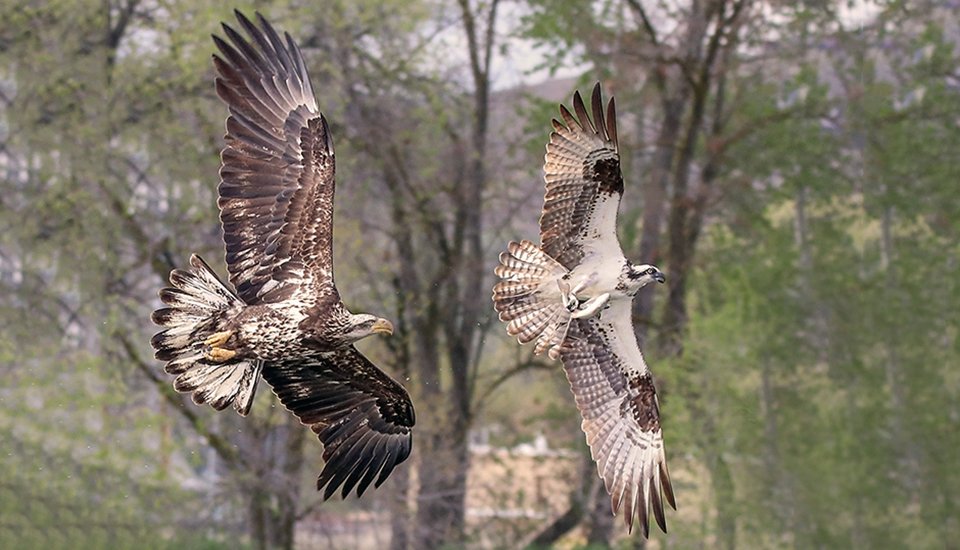For More Information
A brief history of the expansion of urban raptors in western Washington was described in 2018 by Bud Anderson, founder of Falcon Research Group, in the Washington Ornithological Society newsletter. This is a modified version of his article.
Urban Raptors: Ecology and Conservation of Birds of Prey in Cities. 2018. Ed. by CW Boal & CR Dykstra. Island Press.
Seattle Raptors

Subadult Bald Eagle pursuing Osprey with fish.
Annette Shaff, Shutterstock.
A raptor, or bird of prey, is a carnivorous bird: it hunts and eats other animals. In addition to their hunting habits, raptors are distinguished from other carnivorous birds by their hooked beaks, sharp, curved talons, and excellent eyesight. Thus, vultures are often called raptors even though they are scavengers of the dead. But crows are called scavengers even though they rob and eat live nestlings as raptors do, because they lack the defining physical traits of raptors.
All native species of birds, including all of the raptors named here, are federally protected by the Migratory Bird Treaty Act of 1918.
Urban History
Urban raptor expansion is happening all across North America. It is also underway in Europe, where Goshawks and Eurasian Sparrowhawks are also moving into cities. In the Pacific Northwest, raptors have been observed in cities for over 60 years.
Raptors commonly found in western Washington cities are Merlins, Red-tailed Hawks, Bald Eagles, Peregrine Falcons, Cooper’s Hawks, Ospreys, Sharp-shinned Hawks, American Kestrels, and Owls.
- Merlins were first documented in a North American city by Lynn Oliphant in 1971 in Saskatoon, Saskatchewan. In Washington, little historic information existed until the 1980s, when long-time raptor observers Tom Gleason, Jim Fackler, and others started finding nesting Merlin pairs on the Olympic Peninsula, up the Skagit and Stillaguamish Rivers, and elsewhere. The first known city pair in Washington was in Bellingham in 2000. Over the next few years, Merlins slowly were found southward from Burlington to Seattle.
- Red-tailed Hawks were first documented in Seattle after the I-5 freeway opened in the mid-1960s.
- Not long afterward, Bald Eagles showed up in Kirkland and Seattle’s Seward Park.
- The first nesting pair of Peregrine Falcons since the ban on the pesticide DDT arrived in Seattle in 1994.
- When Cooper’s Hawks first began to breed in the city is unknown. Butch Olendorff found a pair on the hillside west of the Duwamish Slough in the late 1960s.
- Ospreys are likely to have been nesting on Lake Washington even further back in time.
Three species of urban raptors in Seattle have been studied for years: Peregrine Falcons, Cooper’s Hawks, and Merlins. Other urban raptors — Sharp-shinned Hawks, American Kestrels, Owl species, Bald Eagles, Ospreys — have long been observed as well. The species accounts that follow describe in more detail the history of these raptor species in Seattle and its urban environs.